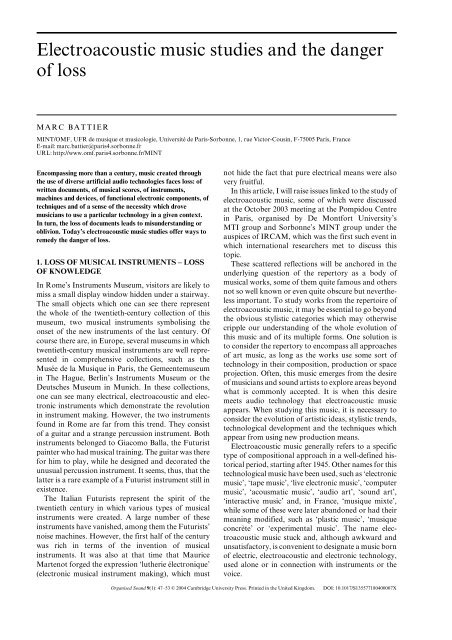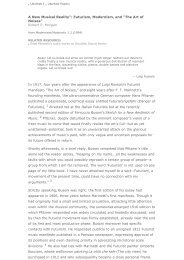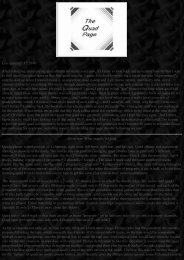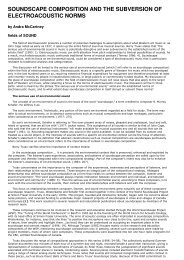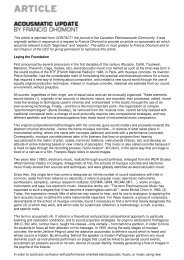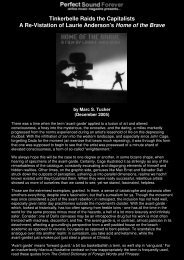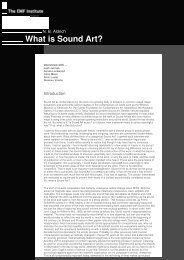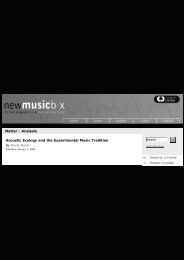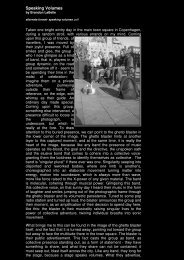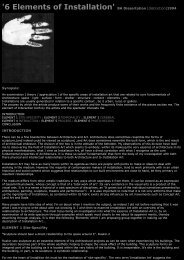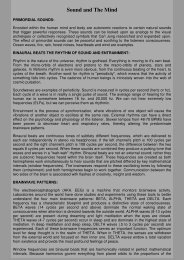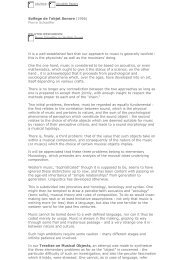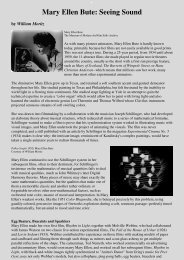Electroacoustic music studies and the danger of loss - Cambridge ...
Electroacoustic music studies and the danger of loss - Cambridge ...
Electroacoustic music studies and the danger of loss - Cambridge ...
You also want an ePaper? Increase the reach of your titles
YUMPU automatically turns print PDFs into web optimized ePapers that Google loves.
<strong>Electroacoustic</strong> <strong>music</strong> <strong>studies</strong> 51Table 1ComputerPeripheralsAudio acquisition <strong>and</strong> conversionMIDIDiffusionMicrophonesEffectsControllersS<strong>of</strong>twareSamplerType used at <strong>the</strong> first performance (to provide an example), speed, RAM memory sizeSize <strong>of</strong> hard disks, o<strong>the</strong>r necessary peripheralsNumber <strong>of</strong> channels, sampling rateNumber <strong>of</strong> channelsNumber <strong>of</strong> loudspeakers. Number <strong>of</strong> channels.Types <strong>of</strong> loudspeak-ers (stage,sub-bass, etc.). Set up in <strong>the</strong> performance hall.Number; types (contact, aerial, HF) <strong>and</strong> models used in <strong>the</strong> first performanceCompressors, limiters, equalisers, reverberation, harmonisers, etc. Precise description<strong>of</strong> models <strong>and</strong> versions for future reference.MIDI keyboard. O<strong>the</strong>r MIDI controllers (faders). Pedals (switch or volume).Joysticks. Non-st<strong>and</strong>ard items (gloves, bodysuits).Name. Version used in <strong>the</strong> first performance. Platform <strong>and</strong> operat-ing system underwhich <strong>the</strong> s<strong>of</strong>tware runs. See S<strong>of</strong>tware environ-ment in table 2.RAM memory size. Sample map. Voice settings (filter, pan, vol-ume, envelope, etc.).Knowledge <strong>of</strong> <strong>the</strong> programming language is a necessityif one wants to grasp fully <strong>the</strong> intention <strong>and</strong> role <strong>of</strong><strong>the</strong>se instructions. This is how <strong>the</strong> analyst can underst<strong>and</strong>how a composer adapted a general-purposelanguage to <strong>the</strong> specific needs <strong>of</strong> <strong>the</strong> work.A recent study <strong>of</strong> Jonathan Harvey’s 1980 tapepiece, Mortuos plango, vivos voco, has shown howvaluable composer sketches are. The original MUSICV texts – orchestras <strong>and</strong> scores – could not be retrieved.To study this pure tape piece, <strong>the</strong> analysthad access to Harvey’s private documents <strong>and</strong> coulddiscuss <strong>the</strong>m with <strong>the</strong> composer. Thus, many compositionaltechniques <strong>of</strong> <strong>the</strong> piece were uncovered <strong>and</strong>thoroughly explained.Because electroacoustic <strong>music</strong> has been in existencefor a ra<strong>the</strong>r long time <strong>and</strong> has generated a whole livingrepertoire, part <strong>of</strong> which is available on commercialrecordings, it is indeed possible to assemble a variety<strong>of</strong> material in order to study <strong>and</strong> analyse an electroacousticpiece or a body <strong>of</strong> work. It is not difficult toaccept <strong>the</strong> idea that such a long history <strong>of</strong> compositionalpractice has generated a volume <strong>of</strong> documentsin addition to <strong>the</strong> <strong>music</strong> itself. Loosely drawing fromarchivistic categorisation, I will subdivide <strong>the</strong>m into‘texts’, ‘paratexts’ <strong>and</strong> ‘documents’.Texts are composed <strong>of</strong> a wide diversity <strong>of</strong> written<strong>and</strong> graphic primary material, such as patches, analoguesyn<strong>the</strong>sizers’ dope sheets, program listings,computer instruments, note lists, <strong>and</strong> so on. Paratextsare heterogeneous elements which help in <strong>the</strong> reception<strong>of</strong> a work, such as titles, epigraphs <strong>and</strong> dedications,<strong>and</strong> commentaries <strong>of</strong> a work such as programmenotes. Documents consist in secondary sources notnecessarily related to <strong>music</strong>: h<strong>and</strong>books <strong>and</strong> manuals<strong>of</strong> various technological tools such as computerprograms <strong>and</strong> audio devices, as well as textsrelated to art history, sociology, ae<strong>the</strong>tics, philosophy,semiotics, cognitve sciences, etc.Table 1 lists <strong>the</strong> information for typical live electronicpieces using real-time digital systems, such asthose produced in <strong>the</strong> early 1980s. It is presented as anexample <strong>of</strong> a guideline for <strong>the</strong> preservation <strong>of</strong> informationdata used for performance <strong>and</strong> should proveuseful in electroacoustic <strong>music</strong> <strong>studies</strong>. It can also beused for tape <strong>music</strong> <strong>and</strong> pieces for tape <strong>and</strong> instrumentsor voice. Table 2 is a blueprint to help in a comprehensivedocumentation <strong>of</strong> pieces using computersin <strong>the</strong>ir performance. It is derived from a templatedevised by <strong>the</strong> author during his tenure at IRCAM in<strong>the</strong> 1990s.There are large institutions which store <strong>and</strong> managedocuments <strong>and</strong> records for this <strong>music</strong>. Librariessuch as <strong>the</strong> Bibliothèque Nationale de France or <strong>the</strong>Library <strong>of</strong> Congress have comprehensive <strong>music</strong> departments.Their collections consist <strong>of</strong> <strong>music</strong>al scores,books, personal archives <strong>and</strong> <strong>music</strong> periodicals. Specialisedlibraries maintain whole collections <strong>of</strong> scientific<strong>and</strong> technical periodicals <strong>and</strong> books; this is <strong>the</strong>case for large university libraries <strong>and</strong> research institutions.Many European radio organisations <strong>and</strong> associatedaudiovisual media institutions tend to do archivalwork by storing large sets <strong>of</strong> audio <strong>and</strong> video recordings,<strong>and</strong> many <strong>of</strong> <strong>the</strong>m are engaged in research fordate retrieval from massive collections <strong>of</strong> documentrecords. Institutions which are or have been doing<strong>music</strong> research <strong>and</strong> production, such as INA-GRM<strong>and</strong> IRCAM in France, or Milan’s RAI are takingimportant steps towards preservation <strong>and</strong> access to<strong>the</strong>ir collection <strong>of</strong> published <strong>and</strong> unpublished material.Also, <strong>music</strong> information centres, such as CDMCin France or <strong>the</strong> ones found in Europe, Japan, NorthAmerica <strong>and</strong> elsewhere, are good places to find
52 Marc BattierTable 2General presentationAudio connections set-upMIDI connections set-upAudio <strong>and</strong> MIDI set-up from <strong>the</strong>first per-formanceDigital processing mapDiffusion set-upList <strong>of</strong> all prepared soundfiles<strong>and</strong> sound samplesS<strong>of</strong>tware environmentSignal processing schemePreparation, tests <strong>and</strong> rehearsalPerformanceProgramme notesThis is where <strong>the</strong> reader should become acquainted with <strong>the</strong> specifics <strong>and</strong> <strong>the</strong> intention<strong>of</strong> a piece, as well as its mode <strong>of</strong> presentation <strong>and</strong> performance. A morecomprehensive study could also be included.Place <strong>of</strong> all necessary microphones; audio signal paths to process-ing devices(reverberation, equalisation, compression, spatialisa-tion, o<strong>the</strong>r processing); A/D <strong>and</strong>D/A conversion; routing <strong>of</strong> output <strong>of</strong> audio signals; mixing; connection toloudspeakers.Must display channel numbers. Should show list <strong>of</strong> MIDI devices, control channels<strong>and</strong> patching.Referring to <strong>the</strong> first performance’s set-up is invaluable. While tech-nology will evolve<strong>and</strong> be replaced in <strong>the</strong> future, a snapshot <strong>of</strong> <strong>the</strong> first performance can explain a lot.When digital processing is used (such as with a computer pro-gramme – MAX/MSP,Super Collider, jMax, etc.), a map <strong>of</strong> <strong>the</strong> data flow, a list <strong>of</strong> processing functions <strong>and</strong>I/O modules as well as a careful notation <strong>of</strong> settings is most useful for study (as well asfor a technical port to latter day technology).Live pieces tend to use more than two channels. A map <strong>of</strong> <strong>the</strong> diffu-sion set-up forspatialisation should clarify <strong>the</strong> choices made by <strong>the</strong> composer <strong>and</strong> those taken by <strong>the</strong>technician for a particular per-formance.Direct-to-disk <strong>and</strong> sampler technology tend to evolve rapidly. It is most important toknow <strong>the</strong> sampler’s map, its program settings <strong>and</strong> <strong>the</strong> triggering systems. Screen shotscan be useful.When triggered from a MIDI device (keyboard or gestural control-ler),precise MIDI messages (usually voice messages) should be noted. It may be that <strong>the</strong>performer’s score has <strong>the</strong>se indications already.In addition to <strong>the</strong> information given in table 1, this is where a com-prehensiveindication <strong>of</strong> <strong>the</strong> overall s<strong>of</strong>tware environment is given (list <strong>of</strong> necessary plug-ins,abstractions, patches, programs, settings).Data flow representation <strong>of</strong> <strong>the</strong> signal processing algorithms.Steps to be followed to install <strong>the</strong> set-up <strong>and</strong> conduct tests. Indica-tion <strong>of</strong> rehearsalprocedure.Steps to be followed <strong>and</strong> overall procedure for <strong>the</strong> performance <strong>of</strong> <strong>the</strong> piece.The programme note is a paratext. As such, it is important to use <strong>the</strong> programmenotes from <strong>the</strong> first performance, although o<strong>the</strong>r versions might have been producedlater.documentation on living composers <strong>and</strong> <strong>music</strong> from<strong>music</strong>ians working in <strong>the</strong>ir own country, such asscores, paratexts, associated documents <strong>and</strong> audiorecordings. Finally, museums not only acquire, store<strong>and</strong> preserve <strong>music</strong>al instruments, but <strong>of</strong>ten giveresearchers access to <strong>the</strong>ir own document recordsarchives.When it comes to classifying methods, one encountersseveral approaches. Museums, for instance,have <strong>the</strong>ir own agenda <strong>of</strong> preserving, restoring <strong>and</strong>sometimes finding ways to keep instruments in aplayable state, <strong>and</strong> accompanying repository documentsare used as technical guidelines for <strong>the</strong>se aims. 5Major libraries, on <strong>the</strong> o<strong>the</strong>r h<strong>and</strong>, especially nationalones, are more focused on archival methods.5On <strong>the</strong> steps taken by a museum regarding electronic <strong>music</strong>alinstruments, see Sylvie Ramel’s article in this issue.One cannot expect electroacoustic <strong>music</strong> centres toconduct thorough data management. Most <strong>of</strong> <strong>the</strong>msimply do not have <strong>the</strong> time, <strong>the</strong> resources, <strong>the</strong> methodology.Their interest lies elsewhere, mostly in <strong>the</strong> production<strong>of</strong> new <strong>music</strong> <strong>and</strong> in its public performance.It is a complex task to ga<strong>the</strong>r <strong>the</strong> documentationnecessary to electroacoustic <strong>music</strong> <strong>studies</strong>.An important missing tool is a <strong>the</strong>saurus. A multilingual<strong>the</strong>saurus would be a useful instrument forunderst<strong>and</strong>ing terms whose meanings are sometimesuncertain or have changed over time. For instance,<strong>the</strong> word ‘sample’ has taken a whole new significance<strong>the</strong>se days. At <strong>the</strong> onset <strong>of</strong> computer <strong>music</strong>, <strong>the</strong> term‘sample’ is what digitalisation <strong>and</strong> sampling <strong>the</strong>orydefines as a single number representing an instantaneousamplitude in a waveform. With <strong>the</strong> arrival <strong>of</strong>real-time recording devices in 1980, <strong>the</strong> word was used
<strong>Electroacoustic</strong> <strong>music</strong> <strong>studies</strong> 53to designate a whole sound which could be playedback on a digital sampler instrument (Davies 1996). 66. CONCLUSIONTo help electroacoustic <strong>music</strong>’s repertory to live, tobe better known <strong>and</strong> performed more <strong>of</strong>ten, effortsshould be made to underst<strong>and</strong> it better. Underst<strong>and</strong>ingtechnological works means studying <strong>the</strong> way <strong>the</strong>yshould be performed, how <strong>the</strong>y ought to be presentedto <strong>the</strong> public <strong>and</strong>, also, <strong>the</strong> technical context in which<strong>the</strong>y were born, <strong>the</strong>ir possibilities, limits <strong>and</strong> resources.REFERENCESBattier, M. 2003. A Constructivist approach to <strong>the</strong> analysis<strong>of</strong> electronic <strong>music</strong> <strong>and</strong> audio art – between instruments<strong>and</strong> faktura. Organised Sound 8(3), pp. 249–55.Bossis, B. 2004. Mortuos Plango, Vivos Voco de JonathanHarvey. In M.-N. Masson (ed.) Les Images de lavoix. Rennes: Presses Universitaires de Rennes, coll.Aes<strong>the</strong>tica, awaiting publication.Busoni, F. 1913. Sketch for a New Es<strong>the</strong>tic <strong>of</strong> Music.Reprinted in Three Classics in <strong>the</strong> Aes<strong>the</strong>tic <strong>of</strong> Music,New York: Dover, 1962.Davies, H. 1968. International Electronic Music Catalog/Répertoire, international des musiques électroacoustiques.<strong>Cambridge</strong>, MA: MIT Press. Also published asElectronic Music Review 2–3.Davies, H. 1996. A history <strong>of</strong> sampling. Organised Sound1(1): 3–11.Glinsky, A. 2000. Theremin. E<strong>the</strong>r Music <strong>and</strong> Espionage.Chicago: University <strong>of</strong> Illinois Press.Laurendeau, J. 1990. Maurice Martenot, luthier del’électronique. Montréal: Louise Courteau.Ma<strong>the</strong>ws, M., with Miller, J. E., Moore, F. R., Pierce, J. R.,<strong>and</strong> Risset, J. C. 1969. The Technology <strong>of</strong> ComputerMusic. <strong>Cambridge</strong>, MA: MIT Press.Moholy-Nagy, L. 1923. New Plasticism in <strong>music</strong>. Originallypublished in Der Sturm, no. 7, 1923, reprinted <strong>and</strong>translated in U. Block <strong>and</strong> M. Glasmeier (eds.) BrokenMusic, pp. 55–6. Berlin: Daadgalerie, Berliner Künstlerprogrammdes DAAD <strong>and</strong> Gelbe Musik, 1989.Risset, J. C. 1969. An Introductory Catalog <strong>of</strong> ComputerSyn<strong>the</strong>sized Sounds. Murray-Hill, N-J: Bell TelephoneLaboratories, 6 + 105 pp.Schedel, M. 2002. Anticipating interactivity: Henry Cowell<strong>and</strong> <strong>the</strong> Rhythmicon. Organised Sound 7(3): 247–54.Stockhausen, K. 1961. Music in space. In Die Reihe,pp. 67–82.Varèse, E. 1936. New instruments <strong>and</strong> new <strong>music</strong> (froma lecture given at Mary Austin House, Santa Fe). In E.Schwartz <strong>and</strong> B. Childs (ed.) Contemporary Composerson Contemporary Music. New York: Norton, 1967.Varèse, L. 1972. Varèse. A Looking-Glass Diary, Volume I:1883–1928. New York: W. W. Norton.Weidenaar, R. H. 1995. Magic Music from <strong>the</strong> Telharmonium.Metuchen, NJ: The Scarecrow Press.Young, G. 1989. Blues for Sackebout. Ottawa: NationalMuseum for Science <strong>and</strong> Technology.6Developing such a <strong>the</strong>saurus forms part <strong>of</strong> <strong>the</strong> EARS project at DeMonfort University.


